In our previous diversity studies on the Academy Awards, the Emmy Awards, the children’s book field, The New York Times Top 10 Bestseller List, Sci-Fi and Fantasy Films, the Tony Awards, and Silicon Valley we interviewed people who actively work in television, publishing, and the theater. We attempted to duplicate this approach for our diversity study on US politics, but with the government shutdown, none of the twelve Congresspeople we contacted responded to our efforts to reach out to them. However, we think the numbers speak for themselves: Continue reading
Tag Archives: Middle Eastern
True or False? Multicultural Books Don’t Sell
We Are the Problem, We Are the Solution
 Elizabeth Bluemle is the co-owner of the Flying Pig Bookstore in Shelburne, VT.
Elizabeth Bluemle is the co-owner of the Flying Pig Bookstore in Shelburne, VT.
As an independent bookseller, former school librarian, and lifelong avid reader, I crave the day when publishing lists are as ![]() diverse and rich as the playgrounds of our nation, and the conversation about representations of diversity in children’s literature is as unnecessary as the question of whether or not women should vote. Until that happens, there is no discussion more vital in the children’s book world than how to bring our industry at every level in line with America’s diversity.
diverse and rich as the playgrounds of our nation, and the conversation about representations of diversity in children’s literature is as unnecessary as the question of whether or not women should vote. Until that happens, there is no discussion more vital in the children’s book world than how to bring our industry at every level in line with America’s diversity.
I’ve written about this subject often over the last several years, for Publishers Weekly’s Shelftalker blog and the CCBC Diversity Committee blog, and while it seems we are, as a whole, talking a lot more about these issues within the field, and while there have been some increase in the number of mainstream children’s books featuring kids of color, we are still so far behind.
The problem is systemic and deeply rooted and requires change at every level, from the publishing houses to artists and writers to booksellers, educators, and ![[A]dults make all kinds of erroneous assumptions about what will and won’t interest children.](http://www.leeandlow.com/images/bookseller-caption1.gif) consumers. We booksellers have more opportunity to effect change than we might imagine. People entrust us with book recommendations from individual purchases to helping plan school curricula on a grand scale, and this affords us the most amazing opportunity to be aware of what we are recommending. One of the challenges inherent in selling children’s books is that we usually have to go through one or two levels of gatekeepers to reach a book’s intended audience, the child reader. We are selling to teachers and librarians, and to parents and other adult family and friends.
consumers. We booksellers have more opportunity to effect change than we might imagine. People entrust us with book recommendations from individual purchases to helping plan school curricula on a grand scale, and this affords us the most amazing opportunity to be aware of what we are recommending. One of the challenges inherent in selling children’s books is that we usually have to go through one or two levels of gatekeepers to reach a book’s intended audience, the child reader. We are selling to teachers and librarians, and to parents and other adult family and friends.
In my seventeen years as a bookseller and three years as a school librarian before that, if there’s one thing I have noticed, it’s that we adults make all kinds of erroneous assumptions about what will and won’t interest children. Time and time again, at the bookstore and at children’s book festivals, I have observed white children picking up books with kids of color on the cover, and heard adults express surprise at the choice. “Are you sure you want that one?” they’ll ask. Or, “Wouldn’t you like this book instead?” It’s not the kids who are the problem. Kids really, really, really only care about a great story. In twenty years of connecting children with books they love, I have only seen one child—ONE!—balk at a book cover because the main character was a different race from her own. It’s the adults who underestimate a child’s ability or desire to see beyond race.
Where’s the Diversity? A Look at the Emmy Awards and TV
Publishing diverse children’s books for more than two decades has given us a unique perspective when it comes to diversity. While our mission is to bring more diverse books to children, we hope our efforts as activists keep the wider conversation on race and inequality in the spotlight. Our other Diversity Gap studies on the Tony Awards, the children’s book industry, US politics, The New York Times Top 10 Bestseller list, Sci-Fi and Fantasy Films, Silicon Valley and the Academy Awards revealed a disturbing trend in ethnic and gender representation. We decided to focus on the television industry next. Continue reading
How to Deal with a Racist Remark
A couple of years ago I wrote a post about being called a racial slur in my hometown. The post generated a lively discussion. As a follow-up, we decided to put together a flow chart that illustrates possible courses of action a person might take when an unfortunate incident like this occurs. While choosing to turn and walk away is always an option, those on the receiving end of racism are fully aware that these incidents are upsetting, and sometimes it makes sense to stand up for yourself and others.
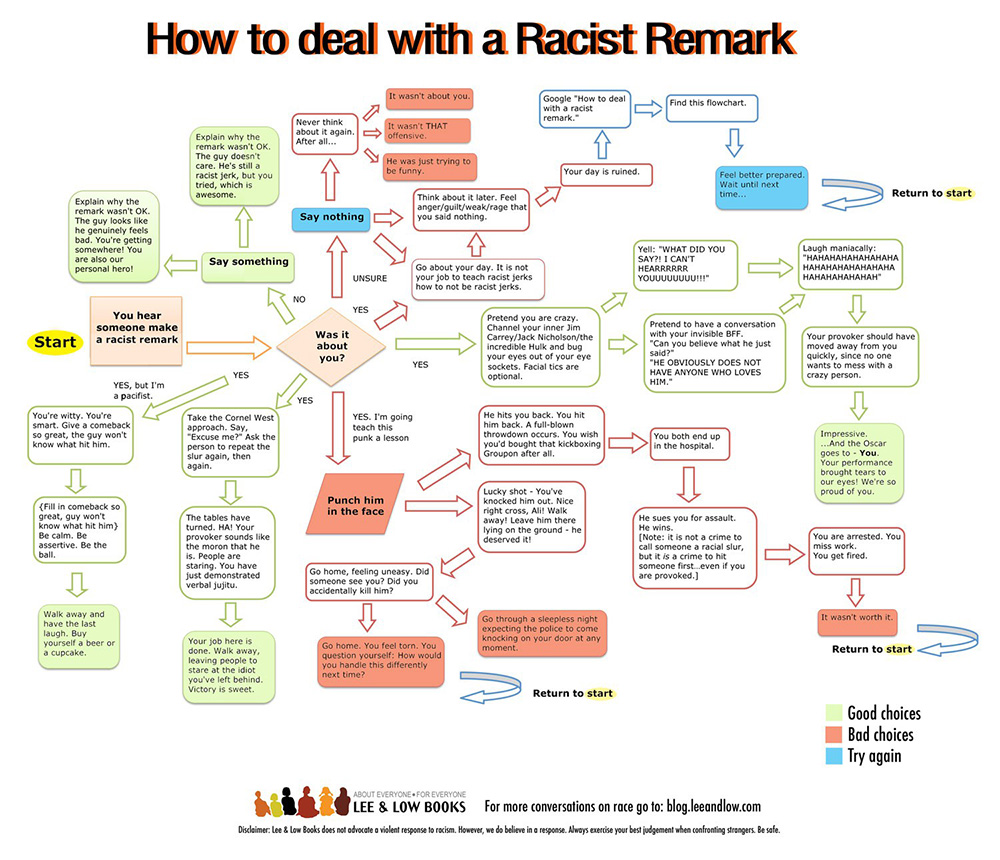
You will notice after viewing the flowchart that one of the scenarios suggests you unleash a comeback that is so brilliant it literally freezes the provoker in his or her tracks. We left this scenario up to your imagination, but we thought it might be productive (and fun) to post our best comebacks in the comments section below. That way we can all benefit from one another’s collective wisdom.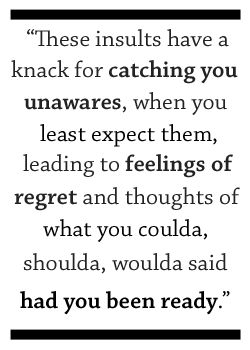
Why Hasn’t the Number of Multicultural Books Increased In Eighteen Years?
Note: This post was originally posted in June 2013. An updated study with new statistics can be found here. The infographic below has also been updated.
Since LEE & LOW BOOKS was founded in 1991 we have monitored the number of multicultural children’s books published each year through the Cooperative Children’s Book Center’s statistics. Our hope has always been that with all of our efforts and dedication to publishing multicultural books for more than twenty years, we must have made a difference. Surprisingly, the needle has not moved. Despite census data that shows 37% of the US population consists of people of color, children’s book publishing has not kept pace. We asked academics, authors, librarians, educators, and reviewers if they could put their fingers on the reason why the number of diverse books has not increased. Continue reading
Where’s the Diversity? The Tony Awards Looks in the Mirror
Though we are a publisher of children’s books, part of our mission is to look at diversity issues with a critical eye and see whose stories are not being told. As part of that mission, over the next several months we will be looking at several different arenas and talking to experts to see if patterns of inequality repeat themselves in different places. We hope our research will cast a light on the challenges – and opportunities – facing women and people of color today.
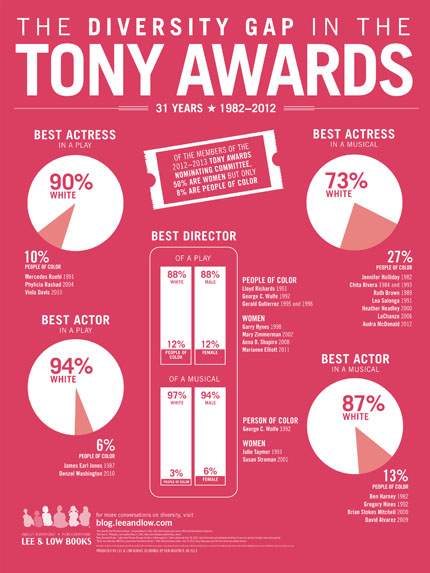
Since the Tony Awards will be presented on June 9, 2013, we decided to collect some data to see if a diversity gap exists in the theater. See our infographic above. While we cannot claim expertise in other fields outside of children’s books, we were fortunate to receive valuable insight from playwright/actor Christine Toy Johnson, who has spent the last fifteen years conducting dialogue with the entertainment industry to increase diversity in the theater and beyond.
 CHRISTINE TOY JOHNSON is an award-winning writer, actor, filmmaker, and advocate for inclusion. Member: BMI Workshop, Dramatists Guild, ASCAP, AEA, SAG-AFTRA, Asian
CHRISTINE TOY JOHNSON is an award-winning writer, actor, filmmaker, and advocate for inclusion. Member: BMI Workshop, Dramatists Guild, ASCAP, AEA, SAG-AFTRA, Asian ![]() American Composers and Lyricists Project (founder), executive board of Alliance for Inclusion in the Arts, elected leadership of Actors’ Equity Association (and co-chair of the union’s EEOC), founding steering committee member of AAPAC. {Read more}
American Composers and Lyricists Project (founder), executive board of Alliance for Inclusion in the Arts, elected leadership of Actors’ Equity Association (and co-chair of the union’s EEOC), founding steering committee member of AAPAC. {Read more}
How old were you when you knew you wanted to perform onstage?
I can’t remember an age when I didn’t want to perform onstage. I was the kind of kid who made my parents’ holiday guests watch my dramatization of “The Twelve Days of Christmas” every year. I started working professionally (and joined Actors’ Equity Association) the summer I graduated from high school, and against all odds, I have made my living in the arts ever since, as both an actor and a writer.
Since you have been involved in the theater for so long, how have you seen the theater world change? Do you feel that the number of roles available to people of color has increased over the years?
Things have gotten better for people of color, for sure, but there is obviously a lot of room for improvement.
I want to preface all of this by saying that I can only really speak from the perspective of being an Asian American actor and writer. I can’t presume to know what it’s like to be African American, Latina, Native American, etc., but the stats I’ve included from AAPAC (see below) will be able to address this question from a more objective point of view.
Back in 1991, I got a chance to play Julie Jordan in a production of CAROUSEL at the Hangar Theatre in Ithaca, 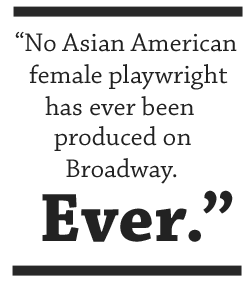 New York, which was a watershed moment for me. Not only was I shocked that I was being given the opportunity to audition (back then, a rare occurrence), but after I booked the job, working with a director and company of actors that supported me and believed in my ability to transform into a non-Asian character in a classic golden age musical gave me the confidence to go for and go on to play many, many more classic non-Asian leading lady roles. The power of encouragement and affirmation from your peers cannot be underestimated.
New York, which was a watershed moment for me. Not only was I shocked that I was being given the opportunity to audition (back then, a rare occurrence), but after I booked the job, working with a director and company of actors that supported me and believed in my ability to transform into a non-Asian character in a classic golden age musical gave me the confidence to go for and go on to play many, many more classic non-Asian leading lady roles. The power of encouragement and affirmation from your peers cannot be underestimated.
As a playwright/librettist/lyricist, I am also acutely aware of the number of writers of color that are being produced, which is a key part of this puzzle. (More on that in a later question.) Personally, I am conscious of always either including an Asian American actor in my written work or telling an aspect of an Asian American character’s story. I believe that the only way we’ll see our roles increase is if more of our stories are produced (written by and/or about us), and/or if more playwrights/directors/producers are open to having people of color play non-race specific roles they write/direct/produce.
First Book, Stories for All Project Chooses LEE & LOW
In a groundbreaking announcement, First Book, a non-profit social enterprise launched the Stories for All Project. The project’s aim is to introduce a significant number of multicultural books into the hands of low-income children. LEE & LOW was chosen as one of two publishers to be a part of this endeavor and receive a $500,000 award.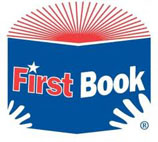
Should I be offended? Race-based comedy
I love comedy. Not doing comedy, but watching comedy, either in film or stand-up. Laughter is good for the spirit.
I like all kinds of comedians—from early Bill Cosby to Jon Stewart. I especially enjoy comedy that makes you think. Comedy can broach taboo topics like racism and stereotypes and make them fair game for open commentary. If done well, these comedic monologues on race can reveal the absurdity of people’s belief systems.
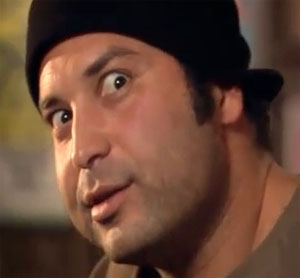
I searched YouTube for examples of race-based comedy that strikes a nerve and found a wide gamut. Will some of these clips offend some people? Maybe. But if you can push yourself outside your comfort level, looking past the profanity and at times crude subject matter, seriously (or humorously) consider what the comedians are trying to do. Are their jokes healing, even when they point out painful truths? Does a line exist, even for comedians, that should never be crossed, or can anything be made fun of in the context of comedy? Is it easier for a comedian who is a person of color to incorporate race in his/her act?
30 Days
Because I do not have cable at home I tend to discover shows on television much later than everyone else. Last week I watched the first three episodes of 30 Days. I liked Super Size Me a lot, and the idea of 30 Days appealed to me because the creator, Morgan Spurlock, tries to push people out of their comfort zones by making them walk (literally) in other people’s shoes.

This Week in Diversity: Bullies, Surfer-Girls, and Ancient Diversity
October is National Bullying Prevention Month, and there are lots of great resources to use in supporting children and teens who are being bullied. We have several books, including First Day in Grapes, Willie Wins, and Chess Rumble. The Department of Health has a Stop Bullying Now site, and the National Center for Bullying has its Kids Against Bullying site; both feature games, videos, and information aimed at elementary-school kids. There’s a brand-new resource for gay, lesbian, bi, and transgender teens: the It Gets Better Project, a collection of videos—most recorded by ordinary people, but also including videos by Hillary Rodham Clinton, President Obama, and other celebrities—encouraging young people to hold on and live, because life gets better after high school. We hope you’ll share your favorite resources in comments.

